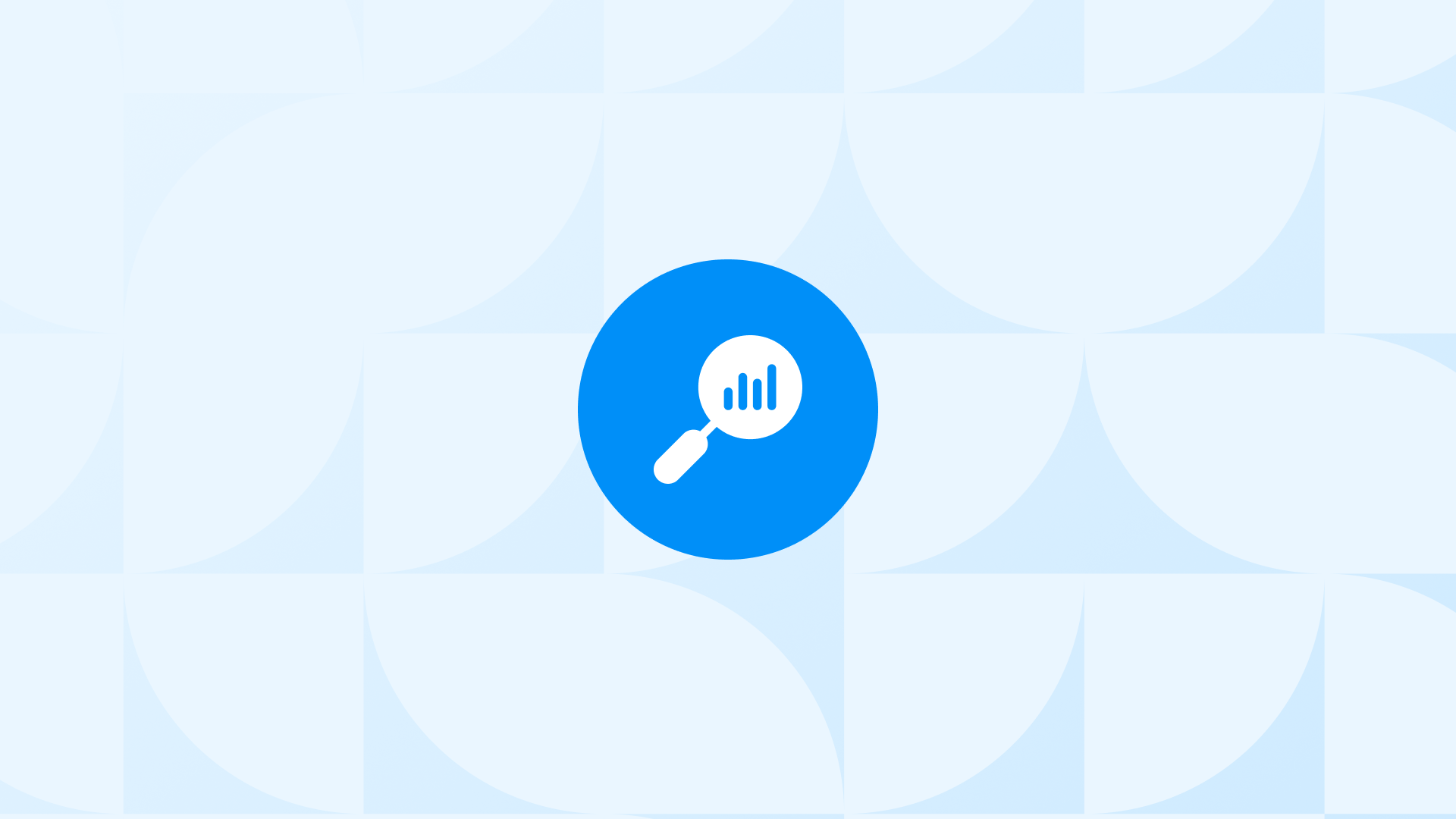As a Shopify merchant, your marketing data is likely spread across GA4, Google Ads, Facebook, Shopify, and even Search Console.
That means multiple tabs, multiple logins, and a whole lot of time wasted just trying to answer basic questions like:
- Where are my customers coming from?
- Which ad campaigns are actually converting?
- What’s driving the most revenue right now?
And when the numbers don’t match up across platforms, it only adds to the confusion.
It shouldn’t be this hard to understand your marketing performance.
The Problem With Your Current Shopify Analytics Setup
By default, Shopify merchants rely on a mix of tools to track performance — native Shopify reports, Google Analytics, ad platforms, and more.
But here’s the real issue: Most Shopify merchants don’t regularly check their reports — either because they’re not sure how to interpret the data, or they feel it takes too much time to dig through separate tools.
They don’t fully trust the numbers, especially from ad platforms, so checking reports feels like a waste of time.
And they keep asking the same questions:
- “I’m spending on ads, but conversions look low — is my tracking broken?”
- “GA4 shows less revenue than Shopify — is GA4 even working?”
- “Why am I wasting time logging into so many tools just to get the basics?”
This kind of setup leads to unclear data and it makes it hard to confidently invest in what’s working.
All Your Key Reports, One Place: Analyzify’s Unified Marketing Analytics For Shopify
Analyzify’s unified marketing analytics dashboard brings all your essential reports from GA4, Google Ads, Meta, Shopify, and Search Console directly into your Shopify admin.
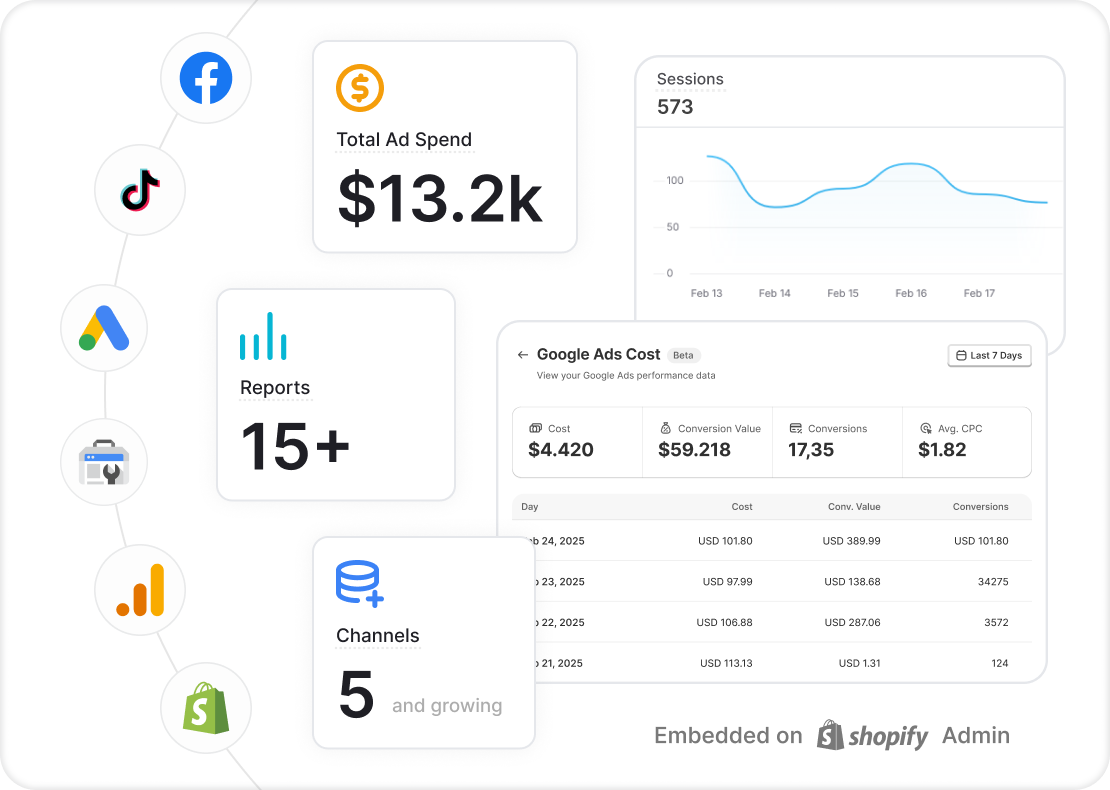
No more switching tabs, logging into multiple platforms, or second guessing your data.
That means you can:
- See what’s working across all marketing channels, instantly
- Track sales, traffic, and conversions from a single, unified marketing dashboard
- Spend less time looking for numbers and more time growing your business
Everything you need is in one place. Simple, accurate, and built for how Shopify merchants actually work.
Here are what is in Analyzify’s unified marketing analytics dashboard:
1. Google Analytics 4 (GA4) Reports
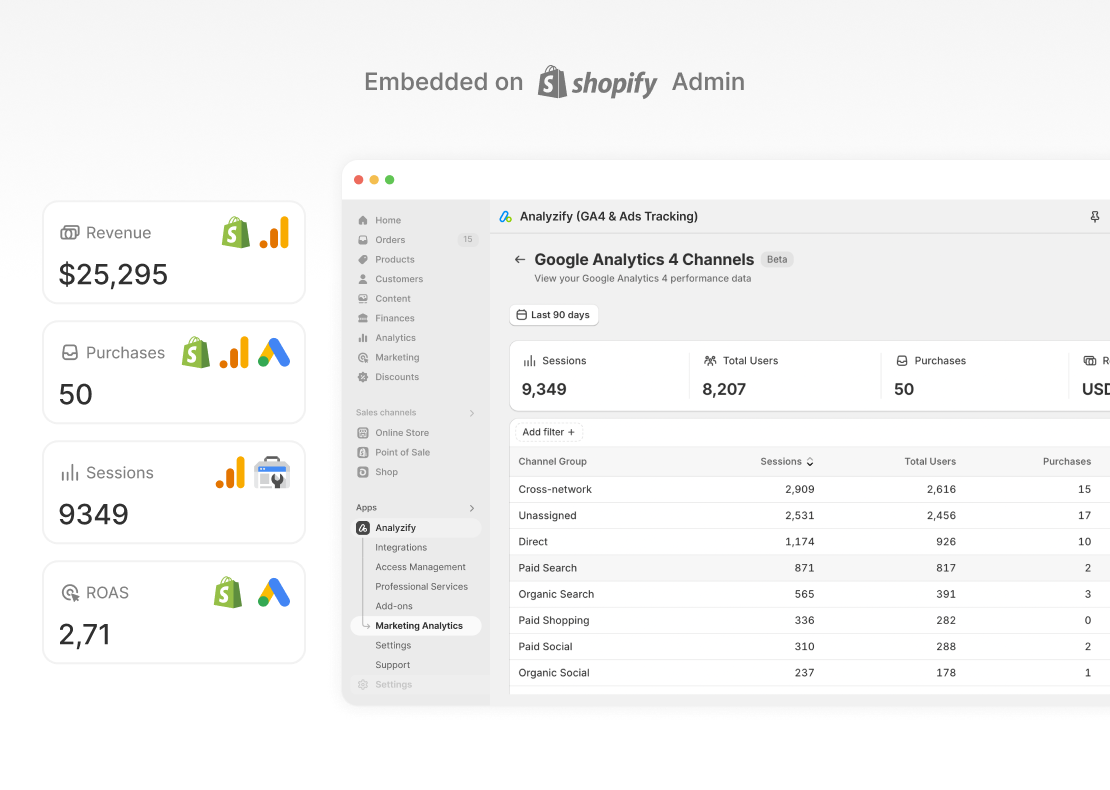
It’s easy to get lost in GA4 when you just need to know what’s converting.
With Analyzify’s unified marketing analytics for Shopify, your most important GA4 reports are simplified and brought right into Shopify.
You’ll get quick access to:
- Sessions overview to track traffic trends
- Top marketing channels bringing in visitors
- Top-viewed products by pageviews
- Revenue generated by referral sources
- Total users and number of purchases
- Item-level insights: views, add-to-cart actions, and item revenue
- Daily trend charts showing sessions vs. users
- Top traffic sources and referrals by revenue
This lets you quickly see which channels and products are performing — and why.
🎯Bonus Content:
- Guide to GA4 Ecommerce Funnels + Reports
- Mastering GA4 for SEO: Top GA4 Reports
- Tracking Content Performance in GA4 With Key Reports
2. Google Ads Reports
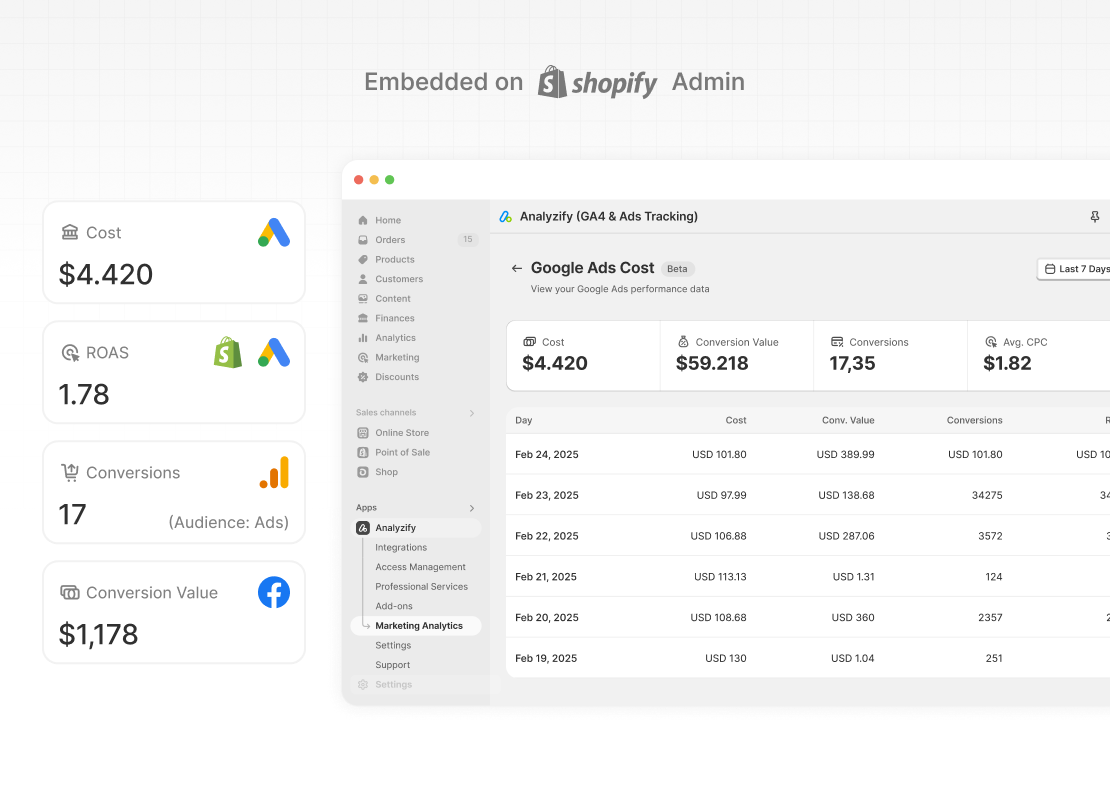
Without clear reporting, it’s hard to tell if your Google Ads are working — or wasting budget.
Analyzify’s unified marketing analytics for Shopify pulls your key Google Ads metrics into Shopify, so you can track performance where it matters most: next to your sales data.
Here’s what you’ll see:
- Total ad spend across campaigns
- Top campaigns ranked by conversion value
- Conversion tracking accuracy in Google Ads tied to actual Shopify orders
- Impressions, clicks, CTR, and average CPC
- Conversion value and cost per conversion
- ROAS (return on ad spend) for each campaign
- Daily graph showing ad spend vs. conversion value
- Full campaign table for side-by-side comparison
You’ll get a clear view of how each campaign is performing and where to optimize for better ROAS.
🎯Bonus Content: Google Ads Ecommerce Reports for Daily Track
3. Shopify Reports
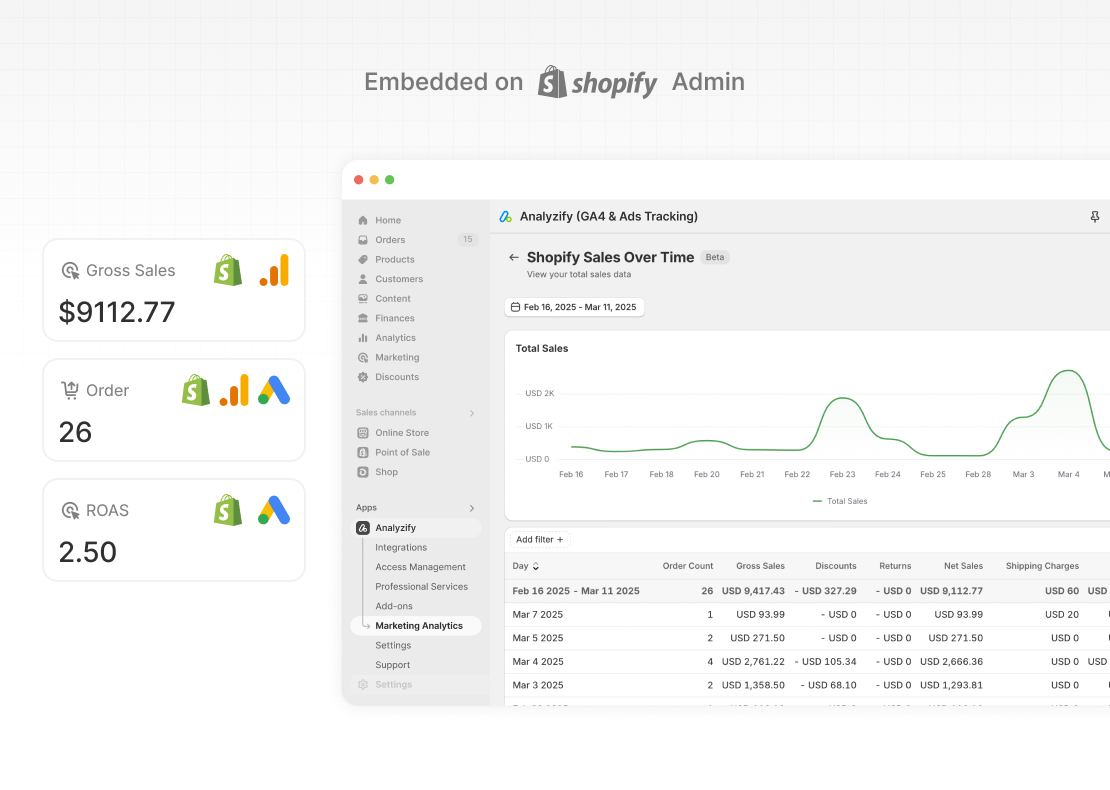
Your store’s performance starts with knowing your core numbers, but Shopify’s built-in reports can feel limited when viewed in isolation.
With Analyzify’s unified marketing analytics for Shopify, you get a simplified view of your most important metrics, side by side with your marketing data.
- Total sales and order volume over time
- Average order value (AOV) to track customer spend
- Gross sales broken down by order
- **Net sales **(after discounts, returns, and cancellations)
- Total discounts, return value, shipping charges, and taxes
- Daily breakdown of orders and sales trends
- Charts showing changes in average order value (AOV)
- Product quantity per order and return tracking
It helps you find top products, track customer behavior, and act on what’s driving sales.
4. Meta (Facebook) Reports
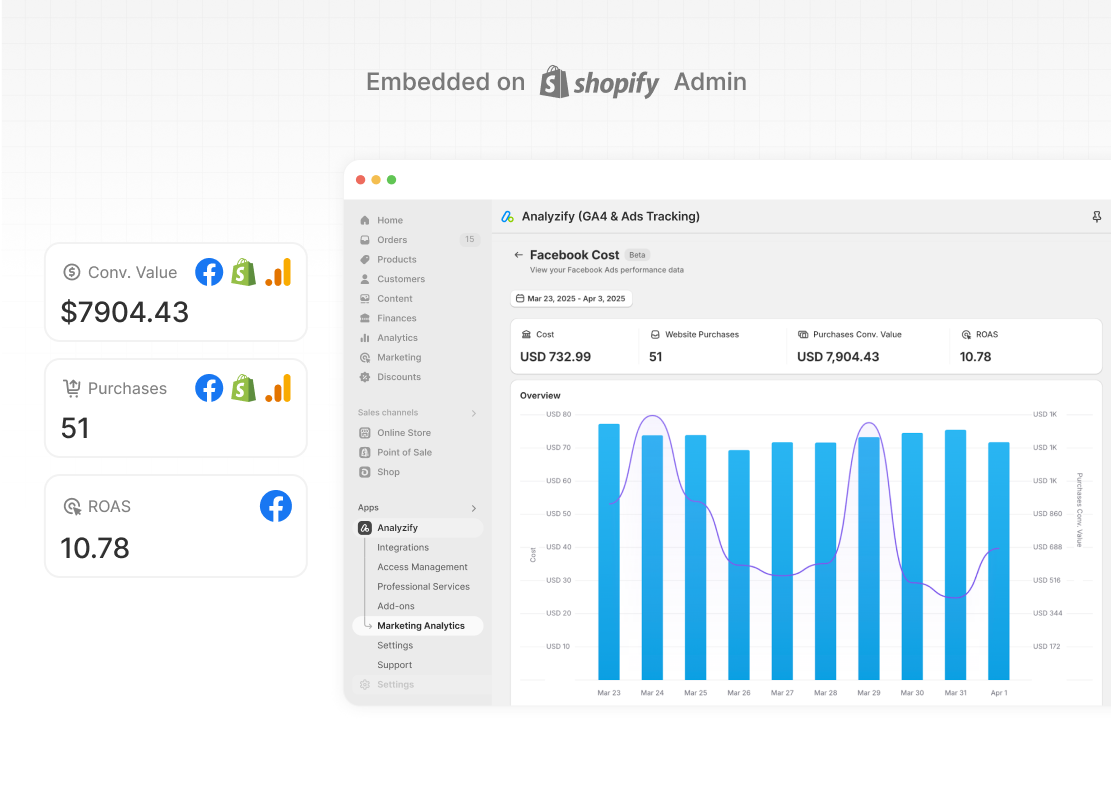
It’s difficult to measure your ROI on Facebook and Instagram without the right data.
Analyzify’s Unified Marketing Analytics Dashboard brings your Meta ad data into Shopify, so you can connect the dots between spend, engagement, and purchases.
- Total ad spend across campaigns
- Click performance to measure engagement
- Website purchases driven by Meta ads
- Top campaigns ranked by conversion value
- CTR and CPC (both link-level and total)
- Cost per result (CPR) for each campaign
- Daily cost vs. conversion charts
- Click trend graph to track engagement
- Campaign-level breakdown with ROAS and conversion value
This helps you understand not just how your ads are performing but whether they’re contributing to actual revenue.
🎯Bonus Content: Analyzify vs. Native Shopify Meta Integration (Facebook)
5. TikTok Reports
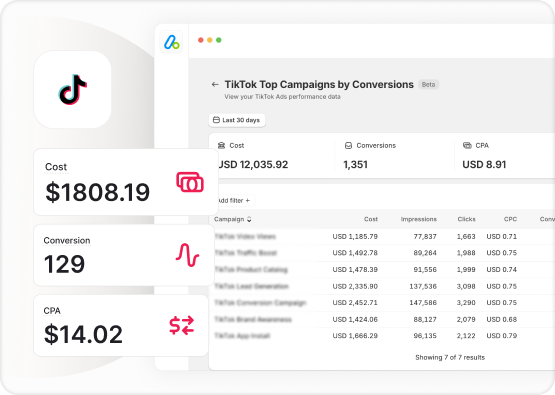
TikTok is a powerful platform for reaching new audiences, but understanding its performance can be difficult when data is scattered across ad dashboards.
With Analyzify, your TikTok ad performance is now fully integrated into your Shopify dashboard.
Reports include:
- Total ad spend per campaign
- Impressions and clicks to measure reach and engagement
- CTR (Click-Through Rate) and CPC (Cost per Click)
- Conversions and CPA (Cost per Acquisition)
- CVR (Conversion Rate) and CPM (Cost per Mille)
- ROAS to track return on your TikTok ad spend
- Daily cost and conversion performance trends
- Campaign-level performance breakdown
You can track how your TikTok ads drive clicks, conversions, and revenue — and take action based on what’s really working, all without leaving your Shopify admin.
6. Search Console Reports

Search Console has valuable SEO data, but it’s often hard to find and even harder to read.
With Analyzify, important Search Console insights are brought into your Shopify dashboard.
Reports include:
- Total clicks from Google Search
- Top search queries bringing visitors to your store
- Most-clicked product and content pages
- Daily trend graph showing clicks and impressions
- Table of top search queries with CTR and average rank
- Table of top-performing pages by clicks and search position
You can see which keywords and pages perform best, then use that info to boost your SEO — no extra tools needed.
Why the Unified Marketing Analytics Dashboard Makes a Real Difference
When your marketing data is all in one place, your decision making gets faster and smarter.
Here’s what you’ll gain:
- Clarity across all your channels — see how each platform contributes to sales
- More time to focus on growth — no more jumping between tools or exporting reports
- Confidence in your numbers — track accurate conversions, revenue, and performance
- Smarter budget decisions — quickly spot which campaigns are worth investing in
Instead of chasing down reports, you’ll spend more time acting on insights that drive results.
More Than Just Reports: How Analyzify Improves Your Entire Analytics Setup
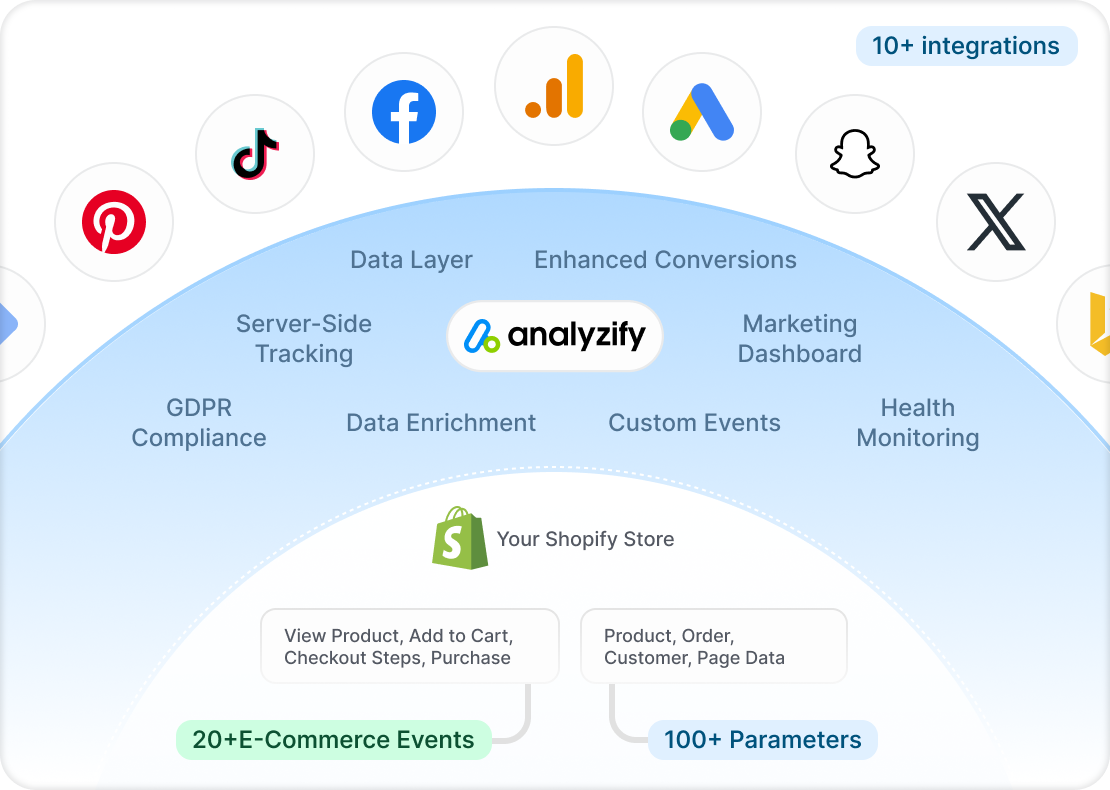
Analyzify’s unified marketing analytics dashboard for Shopify gives you a clear, easy way to view your marketing performance but that clarity starts with having the right data first.
That’s why Shopify merchants rely on Analyzify to keep their data clean and reliable.
Behind our dashboard is a solid tracking system that’s built for accuracy and long-term use.
With Analyzify, you also get:
- Expert setup and validation — we don’t just install tags; we ensure every event and revenue source is tracked correctly
- Automatic updates and ongoing maintenance — so your tracking stays in sync with Shopify, GA4, Meta, and more
- Server-side tracking (GA4, Meta, TikTok) — increasing your data accuracy to up to 98% with GA4 purchase event and higher EMQ (event match quality) scores for Meta, and TikTok
- Custom data layers — enabling advanced tracking setups without relying on third-party scripts
- Privacy-first features — including GDPR/CCPA compliance and Google Consent Mode integration
- Multi-store support — ideal if you manage more than one Shopify storefront and want consistent tracking across all of them
So while the dashboard helps you see what’s happening, the real power comes from knowing the data behind it is clean, complete, and built for long-term growth.
🎯 Learn More: A More Powerful Analyzify (Reliable & Simple Shopify Data Analytics)
👉 Book a free demo to see how Analyzify can help you track, analyze, and optimize your store’s performance with ease.
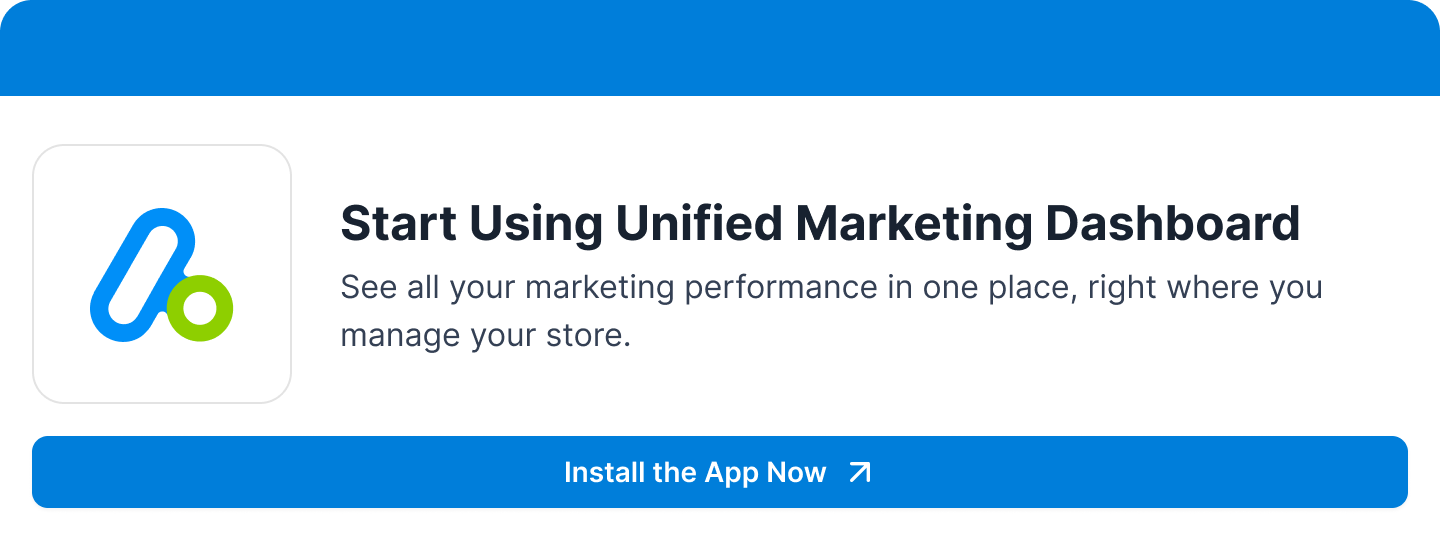
FAQs: Unified Marketing Analytics For Shopify With Analyzify
Here are the most frequently asked questions about the challenges of using multiple marketing dashboards, and how to solve them:
How can I see my Google Analytics (GA4) data inside Shopify?
With Analyzify’s unified marketing analytics for Shopify, you can access your most important GA4 metrics — including sessions, traffic channels, top products by views, and revenue by referral sources — right inside your Shopify admin.
Is there a way to track my Google Ads performance from Shopify?
Analyzify’s marketing dashboard for Shopify gives you a clear view of your Google Ads performance, including ad spend, top campaigns by conversion value, and actual conversions tracked through Shopify orders. This means you’ll no longer have to compare disconnected reports — you’ll see how your ad spend translates into real sales, all in one place.
How can I monitor Facebook ad performance in my Shopify store?
Analyzify’s unified marketing analytics for Shopify pulls in your Meta (Facebook and Instagram) ad data — including total spend, clicks, website purchases, and top-performing campaigns — and displays it alongside your store’s revenue metrics.
Can I access Google Search Console reports from Shopify?
Analyzify’s unified marketing analytics for Shopify integrates with Google Search Console to show your top-performing queries, highest-traffic pages, and total clicks — all inside your Shopify admin. This gives you a clear picture of how customers are finding your store through search, and what you can improve to grow organic traffic.
What kind of Shopify data can I analyze with this dashboard?
Alongside marketing data, Analyzify’s marketing dashboard includes key Shopify reports like total sales, total orders, average order value (AOV), and gross sales by order.
Do I need to connect all platforms to use the dashboard?
Not at all. You can start with just one or two platforms (like GA4 or Meta), and Analyzify’s marketing dashboard will only show the reports that apply to your setup. You can connect more channels later, and the reports will automatically update without requiring a manual configuration.
Can I view all my marketing analytics directly in Shopify?
Yes. With Analyzify’s unified marketing analytics for Shopify, your GA4, Google Ads, Meta, Search Console, and Shopify reports are all embedded directly in your Shopify admin.
How accurate is the marketing data in Analyzify’s dashboard?
Analyzify uses both client-side and server-side tracking, delivering up to 98% accuracy for GA4 purchase events. We also validate and monitor your data setup to ensure your reports reflect the real performance of your campaigns and sales.
How do I set up Unified Marketing Analytics in my Shopify store?
Setup is fast and fully supported by our expert team. Once you install Analyzify and connect your marketing channels, your unified reports will appear automatically in your Shopify admin. Our team also handles the validation process to make sure your tracking is clean, accurate, and ready for use.































